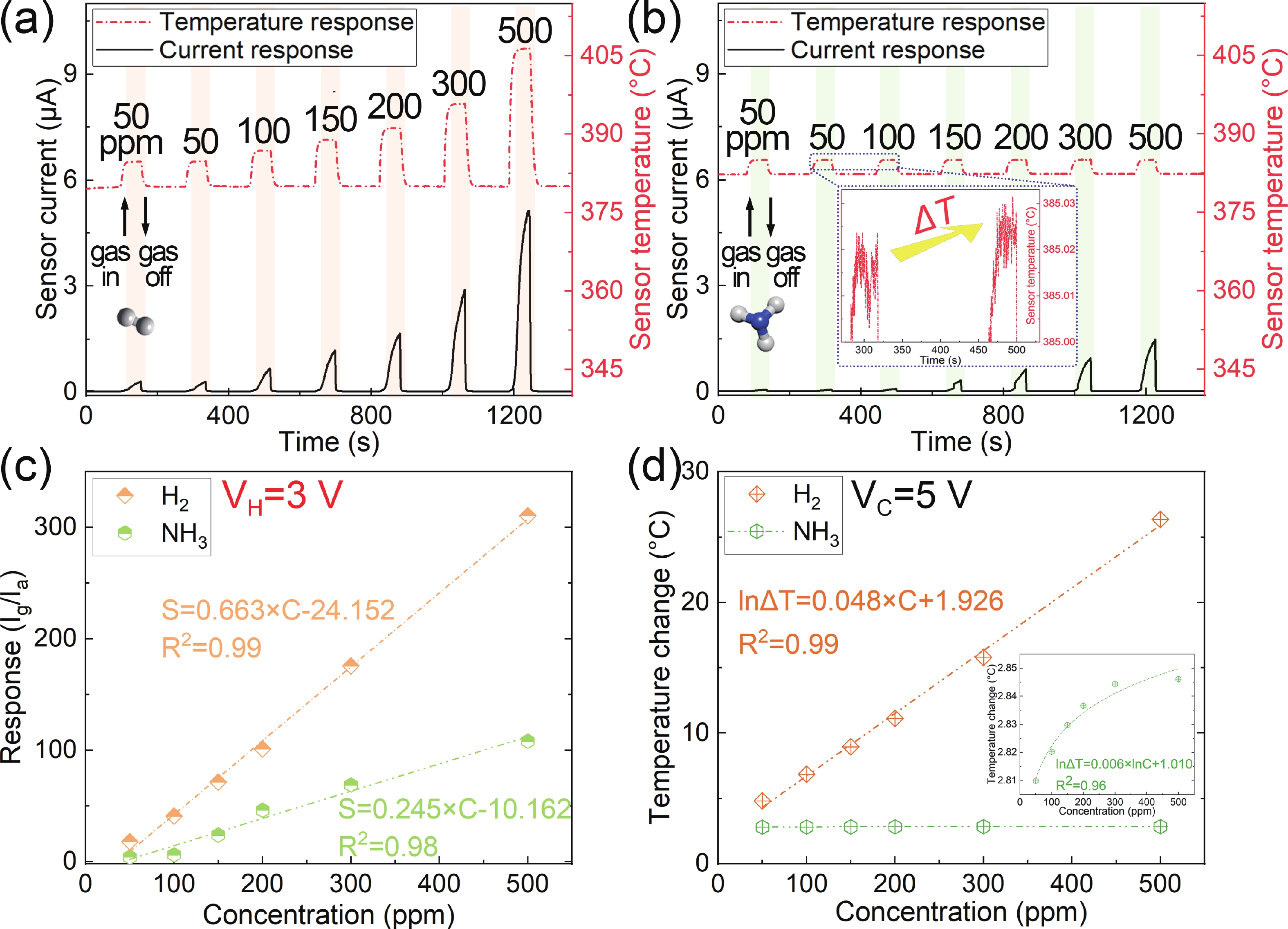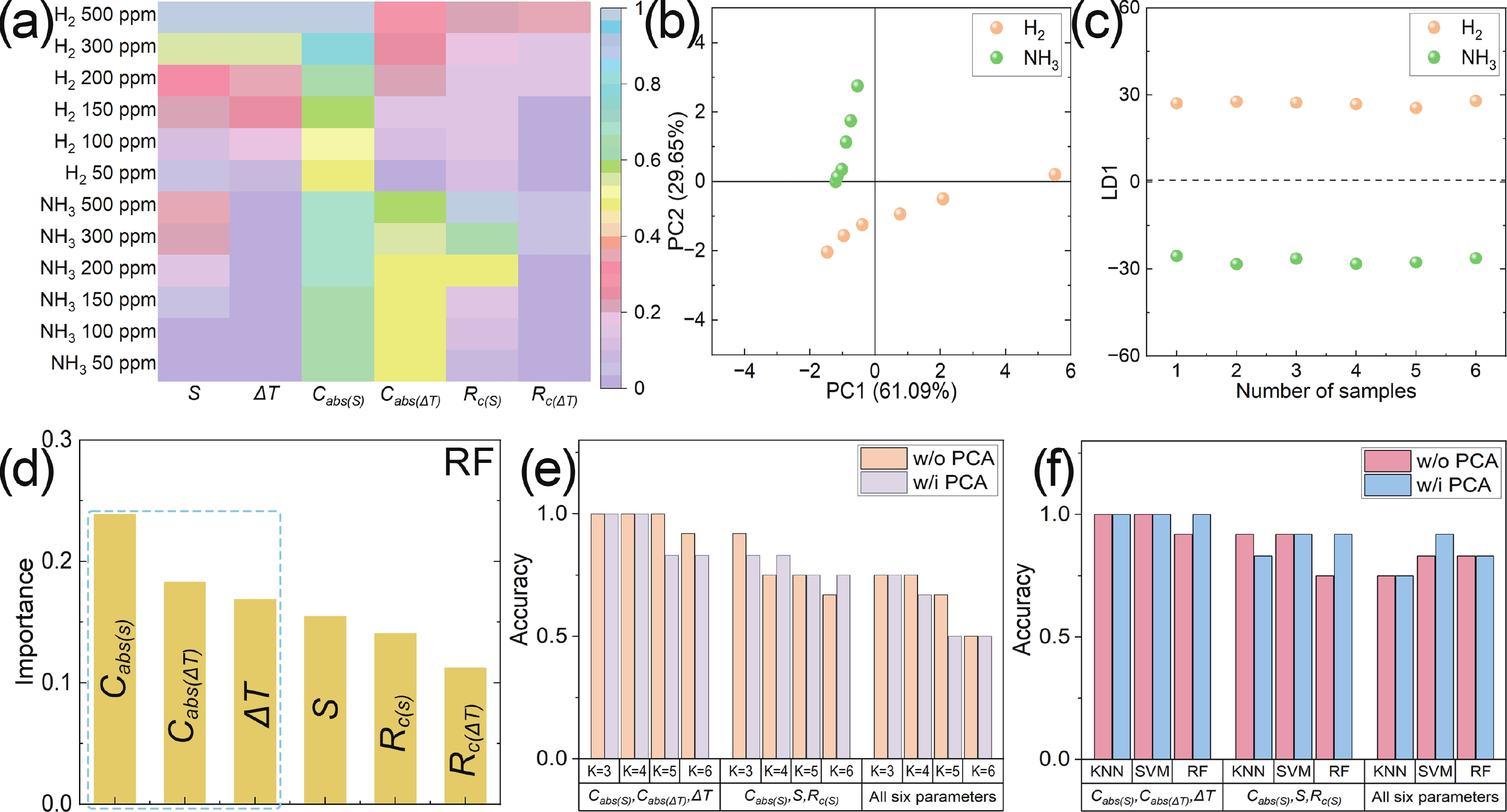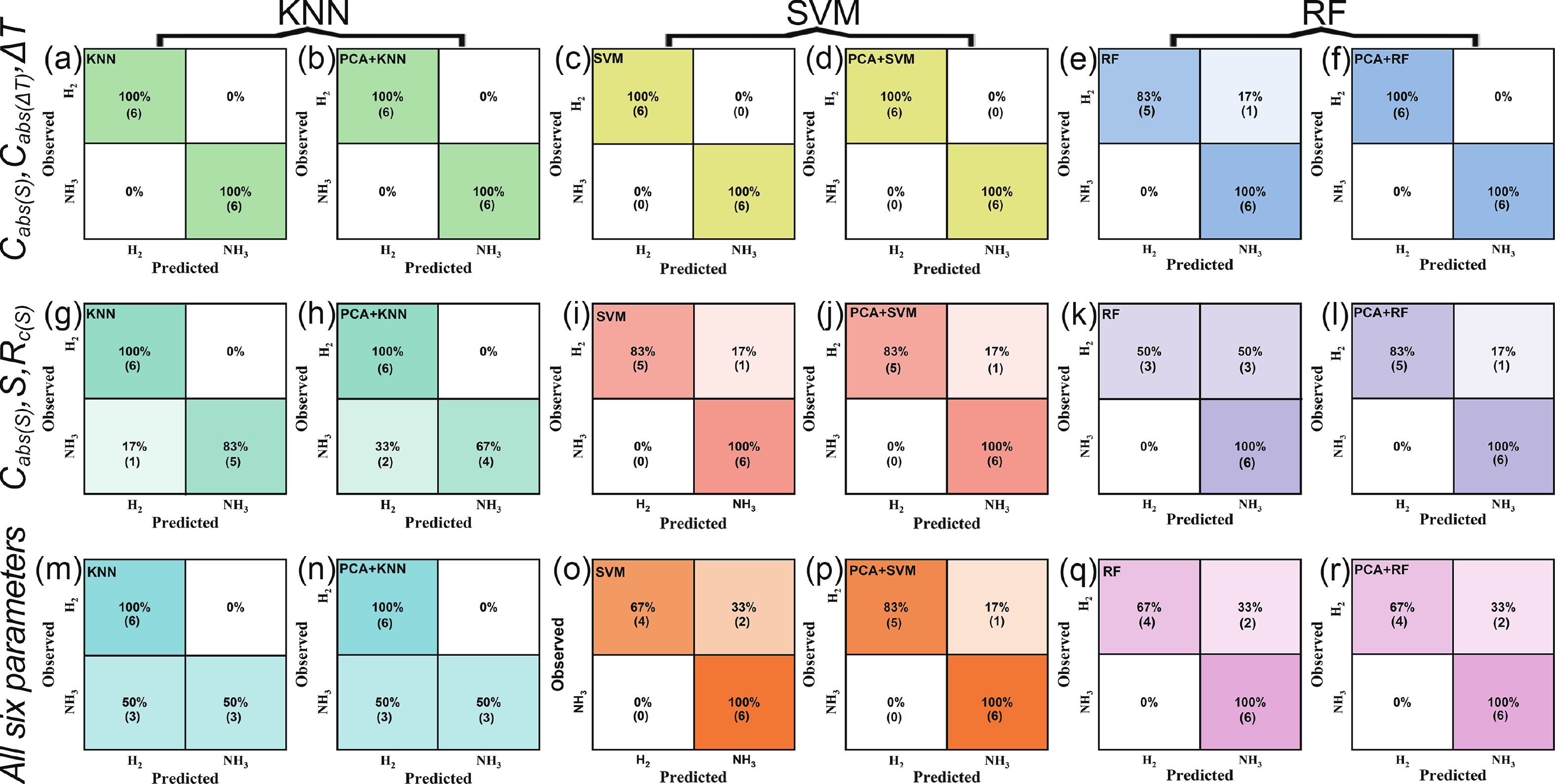| Citation: |
Wenxin Luo, Yingcong Zheng, Yijun Liu, Mingjie Li. Identification of H2 and NH3 gases using calorimetric signals and transient response through machine learning[J]. Journal of Semiconductors, 2026, In Press. doi: 10.1088/1674-4926/25040018
****
W X Luo, Y C Zheng, Y J Liu, and M J Li, Identification of H2 and NH3 gases using calorimetric signals and transient response through machine learning[J]. J. Semicond., 2026, 47(2), 022303 doi: 10.1088/1674-4926/25040018
|
Identification of H2 and NH3 gases using calorimetric signals and transient response through machine learning
DOI: 10.1088/1674-4926/25040018
CSTR: 32376.14.1674-4926.25040018
More Information-
Abstract
Selectivity remains a significant challenge for gas sensors. In contrast to conventional gas sensors that depend solely on conductivity to detect gases, we exploited a single NiO-doped SnO2 sensor to simultaneously monitor transient changes in both sensor conductivity and temperature. The distinct response profiles of H2 and NH3 gases were attributed to differences in their redox rates and enthalpy changes during chemical reactions, which provided an opportunity for gas identification using machine learning (ML) algorithms. The test results indicate that preprocessing the extracted calorimetric and chemi-resistive parameters using the principal component analysis (PCA), followed by the application of ML classifiers for identification, enables a 100% accuracy for both target analytes. This work presents a facile gas identification method that enhances chip-level sensor applications while minimizing the need for complex sensor arrays.-
Keywords:
- MOS sensor,
- gas identification,
- MEMS technology,
- algorithm analysis
-
References
[1] Ahmad Asri M I, Hasan M N, Ahmad Fuaad M R, et al. MEMS gas sensors: A review. IEEE Sens J, 2021, 21(17), 18381 doi: 10.1109/JSEN.2021.3091854[2] Chen Y L, Li M J, Yan W J, et al. Sensitive and low-power metal oxide gas sensors with a low-cost microelectromechanical heater. ACS Omega, 2021, 6(2), 1216 doi: 10.1021/acsomega.0c04340[3] Luo W X, Dai F, Liu Y J, et al. Pulse-driven MEMS gas sensor combined with machine learning for selective gas identification. Microsyst Nanoeng, 2025, 11(1), 72 doi: 10.1038/s41378-025-00934-2[4] Yan W J, Luo W X, Li J H, et al. Highly selective MEMS gas sensor to detect H2 and NH3 with tunable discrimination. IEEE Sens J, 2024, 24(6), 7473 doi: 10.1109/JSEN.2024.3360299[5] Su S F, Hu J H. Gas identification by a single metal-oxide-semiconductor sensor assisted by ultrasound. ACS Sens, 2019, 4(9), 2491 doi: 10.1021/acssensors.9b01113[6] Tonezzer M, Masera L, Thai N X, et al. Miniaturized multisensor system with a thermal gradient: Performance beyond the calibration range. J Sci Adv Mater Devices, 2023, 8(3), 100562 doi: 10.1016/j.jsamd.2023.100562[7] Zhou Y M, Heng Y L, Zhu J T, et al. Enhanced gas recognition of electronic nose using 1-D convolutional neural network with savitzky–golay filter. IEEE Sens J, 2024, 24(7), 10769 doi: 10.1109/JSEN.2024.3363698[8] Gao F, Boussaid F, Xuan W P, et al. Dual transduction surface acoustic wave gas sensor for VOC discrimination. IEEE Electron Device Lett, 2018, 39(12), 1920 doi: 10.1109/LED.2018.2874821[9] Luo W X, Li J H, Li M J. A single MEMS sensor based on SnO2 nanosheets for selective gas identification. IEEE Trans Electron Devices, 2024, 71(11), 7016 doi: 10.1109/TED.2024.3464573[10] Hu K L, Wang F P, Liu H C, et al. Enhanced hydrogen gas sensing properties of Pd-doped SnO2 nanofibres by Ar plasma treatment. Ceram Int, 2020, 46(2), 1609 doi: 10.1016/j.ceramint.2019.09.132[11] Cai Z C, Park S. Synthesis of Pd nanoparticle-decorated SnO2 nanowires and determination of the optimum quantity of Pd nanoparticles for highly sensitive and selective hydrogen gas sensor. Sens Actuat B Chem, 2020, 322, 128651 doi: 10.1016/j.snb.2020.128651[12] Duan P Y, Xiao H H, Wang Z Y, et al. Hydrogen sensing properties of Pd/SnO2 nano-spherical composites under UV enhancement. Sens Actuat B Chem, 2021, 346, 130557 doi: 10.1016/j.snb.2021.130557[13] Yin X T, Tao L. Fabrication and gas sensing properties of Au-loaded SnO2 composite nanoparticles for low concentration hydrogen. J Alloys Compd, 2017, 727, 254 doi: 10.1016/j.jallcom.2017.08.122[14] Niu G Q, Zhao C H, Gong H M, et al. NiO nanoparticle-decorated SnO2 nanosheets for ethanol sensing with enhanced moisture resistance. Microsyst Nanoeng, 2019, 5, 21 doi: 10.1038/s41378-019-0060-7[15] Raza M H, Kaur N, Comini E, et al. Toward optimized radial modulation of the space-charge region in one-dimensional SnO2-NiO core-shell nanowires for hydrogen sensing. ACS Appl Mater Interfaces, 2020, 12(4), 4594 doi: 10.1021/acsami.9b19442[16] Liu H C, Wang F P, Hu K L, et al. Superior hydrogen sensing property of porous NiO/SnO2 nanofibers synthesized via carbonization. Nanomaterials, 2019, 9(9), 1250 doi: 10.3390/nano9091250[17] Yan W J, Luo W X, Li M J. NiO nanoparticles-based gas sensors: A novel pulse-driven approach for enhanced and efficient hydrogen detection. Int J Hydrog Energy, 2024, 85, 481 doi: 10.1016/j.ijhydene.2024.08.293[18] Li M J, Luo W X, Liu X J, et al. Wafer-level patterning of SnO nanosheets for MEMS gas sensors. IEEE Electron Device Lett, 2022, 43(11), 1981 doi: 10.1109/LED.2022.3204292[19] Luo W X, Li J H, Li M J. MEMS gas sensors based on In2O3-decorated SnO2 nanosheets for aniline detection. IEEE Sens J, 2024, 24(19), 29669 doi: 10.1109/JSEN.2024.3441052[20] Gao F, Xuan W P, Bermak A, et al. Dual transduction on a single sensor for gas identification. Sens Actuat B Chem, 2019, 278, 21 doi: 10.1016/j.snb.2018.09.029[21] Hassan M, Liu S W, Liang Z P, et al. Revisiting traditional and modern trends in versatile 2D nanomaterials: Synthetic strategies, structural stability, and gas-sensing fundamentals. J Adv Ceram, 2023, 12(12), 2149 doi: 10.26599/JAC.2023.9220810[22] Yang S X, Jiang C B, Wei S H. Gas sensing in 2D materials. Appl Phys Rev, 2017, 4(2), 021304 doi: 10.1063/1.4983310[23] Li M J, Luo A X, Luo W X, et al. Recent progress on mechanical optimization of MEMS electret-based electrostatic vibration energy harvesters. J Microelectromech Syst, 2022, 31(5), 726 doi: 10.1109/JMEMS.2022.3194859[24] Li M J, Luo A X, Luo W X, et al. Electrostatic vibration energy harvester with a self-rechargeable electret. IEEE Electron Device Lett, 2023, 44(3), 540 doi: 10.1109/LED.2023.3240836[25] Li M J, Luo W X, Yan W J. Low concentration CO gas sensor based on pulsed-heating and wafer-level fabricated MEMS hotplate. IEEE Electron Device Lett, 2024, 45(4), 689 doi: 10.1109/LED.2024.3359637[26] Chen Y, Xu P C, Li X X, et al. High-performance H2 sensors with selectively hydrophobic micro-plate for self-aligned upload of Pd nanodots modified mesoporous In2O3 sensing-material. Sens Actuat B Chem, 2018, 267, 83 doi: 10.1016/j.snb.2018.03.180[27] Adedokun G, Geng L, Xie D C, et al. Low power perforated membrane microheater. Sens Actuat A Phys, 2021, 322, 112607 doi: 10.1016/j.sna.2021.112607[28] Li M J, Luo W X, Yan W J. High performance H2 sensors based on NiO-SnO2 nanosheets in temperature-pulsed operation mode. Smart Mater Struct, 2024, 33(6), 06LT01 doi: 10.1088/1361-665X/ad4cc1[29] Qiu S S, Gao L P, Wang J. Classification and regression of ELM, LVQ and SVM for E-nose data of strawberry juice. J Food Eng, 2015, 144, 77 doi: 10.1016/j.jfoodeng.2014.07.015[30] Zhang H H, Wei W, Tao T Y, et al. Hierarchical NiO/TiO2 heterojuntion-based conductometric hydrogen sensor with anti-CO-interference. Sens Actuat B Chem, 2023, 380, 133321 doi: 10.1016/j.snb.2023.133321[31] Gui Y W, Liu Z T, Feng X B, et al. One-step electrodeposition synthesis of NiFePS on carbon cloth as self-supported electrodes for electrochemical overall water splitting. J Colloid Interface Sci, 2024, 673, 444 doi: 10.1016/j.jcis.2024.06.096[32] Zhang D Z, Yang Z M, Yu S J, et al. Diversiform metal oxide-based hybrid nanostructures for gas sensing with versatile prospects. Coord Chem Rev, 2020, 413, 213272 doi: 10.1016/j.ccr.2020.213272[33] Wang Y, Zhang H, Sun X H. Electrospun nanowebs of NiO/SnO2 p-n heterojunctions for enhanced gas sensing. Appl Surf Sci, 2016, 389, 514 doi: 10.1016/j.apsusc.2016.07.073[34] Cao Z M, Ge Y Z, Wang W, et al. Chemical discrimination of benzene series and molecular recognition of the sensing process over Ti-doped Co3O4. ACS Sens, 2022, 7(6), 1757 doi: 10.1021/acssensors.2c00685[35] Badie C, Mirzaei A, Lee J H, et al. Selective detection of H2 gas in gas mixtures using NiO-shelled Pd-decorated ZnO nanowires. Adv Mater Technol, 2024, 9(13), 2302081 doi: 10.1002/admt.202302081[36] Li Z J, Wang N N, Lin Z J, et al. Room-temperature high-performance H2S sensor based on porous CuO nanosheets prepared by hydrothermal method. ACS Appl Mater Interfaces, 2016, 8(32), 20962 doi: 10.1021/acsami.6b02893[37] Tang Y L, Li Z J, Zu X T, et al. Room-temperature NH3 gas sensors based on Ag-doped γ-Fe2O3/SiO2 composite films with sub-ppm detection ability. J Hazard Mater, 2015, 298, 154 doi: 10.1016/j.jhazmat.2015.04.044[38] Bouricha B, Souissi R, Bouguila N, et al. A real-time sharp selectivity with In2S3 gas sensor using a nonlinear dynamic response for VOCs. Measurement, 2021, 185, 110070 doi: 10.1016/j.measurement.2021.110070[39] Wu T H, Tseng Z C, Huang C Y. Recognition of NO2 and O3 gases using patterned Cu2O nanoparticles on IGZO thin films through machine learning. J Mater Chem C, 2024, 12(45), 18427 doi: 10.1039/D4TC03451A[40] Liu C, Sun Y, Guo J Y, et al. Gas sensor array based on carbon-based thin-film transistor for selective detection of indoor harmful gases. Rare Met, 2024, 43(9), 4401 doi: 10.1007/s12598-024-02776-9[41] Kim T, Kim Y, Cho W, et al. Ultralow-power single-sensor-based E-nose system powered by duty cycling and deep learning for real-time gas identification. ACS Sens, 2024, 9(7), 3557 doi: 10.1021/acssensors.4c00471 -
Supplements
 Supplementary_Material.pdf
Supplementary_Material.pdf

-
Proportional views





 Wenxin Luo received her Bachelor’s degree from Heibei University in 2019, and her Master’s degree from Southern University of Science and Technology (SUSTech) in 2021. She is currently pursuing a Ph.D. degree at the School of Integrated Circuits, Guangdong University of Technology. Her research focuses on micro/nano fabrication and COMSOL modeling.
Wenxin Luo received her Bachelor’s degree from Heibei University in 2019, and her Master’s degree from Southern University of Science and Technology (SUSTech) in 2021. She is currently pursuing a Ph.D. degree at the School of Integrated Circuits, Guangdong University of Technology. Her research focuses on micro/nano fabrication and COMSOL modeling. Mingjie Li received a Bachelor's degree with high distinction at The Pennsylvania State University in 2014, he earned a Ph.D. degree at Rensselaer Polytechnic Institute (RPI) in 2018. Following postdoctoral positions at RPI and Southern University of Science and Technology (SUSTech), he has been a Research Assistant Professor at SUSTech since 2021. In 2023, he was appointed to the faculty of the School of Integrated Circuits at Guangdong University of Technology. His research interests include micro/nano fabrication and devices.
Mingjie Li received a Bachelor's degree with high distinction at The Pennsylvania State University in 2014, he earned a Ph.D. degree at Rensselaer Polytechnic Institute (RPI) in 2018. Following postdoctoral positions at RPI and Southern University of Science and Technology (SUSTech), he has been a Research Assistant Professor at SUSTech since 2021. In 2023, he was appointed to the faculty of the School of Integrated Circuits at Guangdong University of Technology. His research interests include micro/nano fabrication and devices.
 DownLoad:
DownLoad:



















